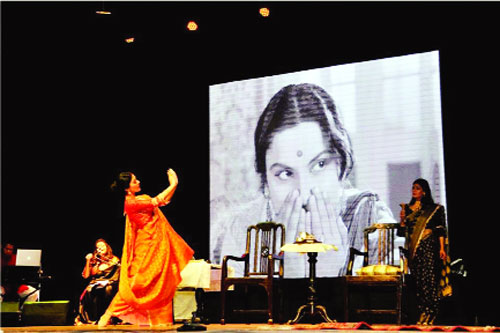Director Ishita Ganguly looks at two of Tagore’s women, Bimala from Ghare Baire and Charu from Noshtonir, through the eyes of his muse Kadambari Devi
It is no secret that Tagore’s women in his novels were inspired by his muse and sister-in-law Kadambari Devi. Though his brother’s wife, the two were more a reflection of each other, sharpening their dialogue, intellect and wit, while glinting off the other like playful soulmates. They were beyond the worldly tags of married or unmarried. Yet when young Tagore got married, Kadambari committed suicide within days, unable to share his being with others. Tagore’s frailty and guilt and Kadambari’s vacuum and hurt were best expressed through his two heroines, Bimala in Ghare Baire and Charu in Noshtonir, which is mostly known asCharulata today following Satyajit Ray’s film. Still, the two are pivoted on Tagore’s understanding of Kadambari. What if Kadambari herself were to recast these two womenIJ That’s precisely what director and writer Isheeta Ganguly did with the musical play Three Women Unplugged at Stein Auditorium over the weekend. Interspersed with Rabindra Sangeet and some English songs, it revealed an engaging transformation of the characters through their conflicted lives.
The protagonists of the play are Bimala (played by Chrisann Perira) and Charulata (played by Mahnaz Damania), fictional characters from Ghare Baire and Nastanirh respectively. Kadambari Devi, played by Avantika Akerkar, engages in a conversation with them. The three ruminate about forbidden love and search for their own identity amid the chaos. Kadambari Devi advises them on how not to be a fool in love and to become complete in their own skin. And through this interaction, there is a kind of catharsis. She urgently pleads that these women should prioritise their lives and not repeat the mistakes she made (she poisoned herself).
For more relatability, the stage had a backdrop plastered from Satyajit Ray's films, Charulata and Ghare Baire, and photographs from Tagore’s early life
Charu and Bimla are upper class Bengali women of the 19th century but their “no holds barred” conversations about errors, regrets, men in their lives, dreams, fantasies, being lovestruck and lovesick have a contemporary resonance. Some modern-day phrases and references have been added in their conversations like the alpha male journalist Arnab Goswami, Hollywood actor Hugh Grant, toy boys, Sex And the City et al. Both the Tagore heroines and Kadambari share similarities of loneliness, falling into the trap of forbidden love, which can never materialise into reality, emotional distancing from their husbands and the betrayal in their own marriage.
At first, Charu and Bimala talk to Devi about the problems in their lives — the emptiness encircling them, the husbands not paying enough attention (Charu) or the loving and caring husband still not being good enough, rather smothering (Bimala). Both fall head over heels in love with men who can never be theirs. After they leave them, they are lovesick, torn apart and clueless as to how to move forward in life. That’s when Kadambari Devi says, “you must be an architect of your own destiny.” She asks Charu to be a writer and Bimala to be a professor.
We then enter into the realm of the modern world with the protagonists dressed in western clothes. Both the women are achievers and do not need to be referenced in the context of the men in their lives. Bimala is a professor of contemporary gender studies in a college and Charu is a writer. They call it their new beginning. And realise that the most important kind of love is self-love. Ganguly gave a fresh angle to Tagore’s acclaimed works which are still relevant in today’s time.
As the director said in her closing remarks, “Fundamentally so little has changed across times. While women have much more social and infrastructural freedom in 2017, the quiet inner struggles remain much the same for women between the Tagore mansion in 1878 and today. The real path, therefore, is about finding one’s own voice, own path and own purpose.”
Ganguly has put her heart and soul into penning the script. “My research for this play spanned two decades of learning Rabindra Sangeet from Suchitra Mitra followed by my meeting with the late director Satyajit Ray and an in-depth study of his adaptation of Tagore’s women,” she added.
























